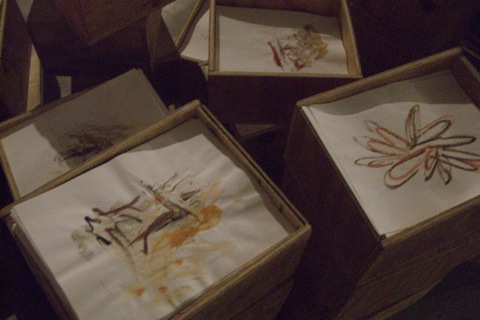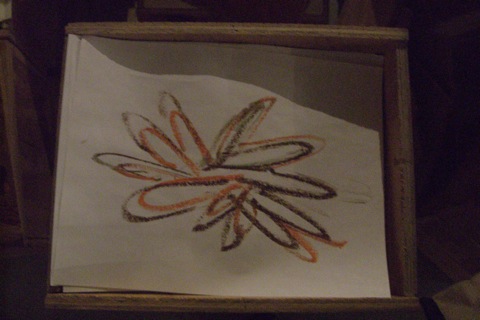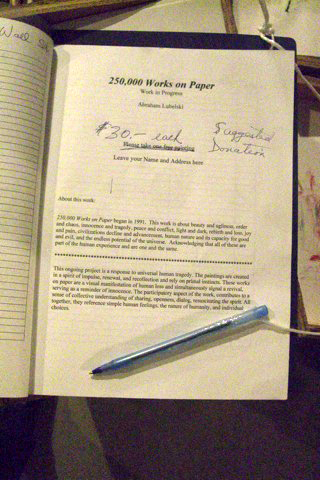
The art of signs used at #OWS (photo from hyperallergic.com)
Throughout history art has been fundamentally intertwined with social movements and political activism and it continually serves as a critical avenue through which to question, comment on, and influence change in the world around it. And this time around is no exception.
While the Occupy Wall Street movement continues to gain momentum, the arts have become a unique tool in the movement’s development and have played a central role in the creative expression of the movement’s message.
On any given day the artistic pulse of the movement can be witnessed through the countless cardboard signs on display throughout downtown Manhattan’s Zuccoti Park, as well as the emergence of a screenprinting lab, daily open stage performances, and the constant presence of musicians who add song to the movement’s message.
Only fourteen days after protesters began occupying, the formation of the Arts and Culture Committee emerged as a subcommittee of the movement’s general assembly. This collection of painters, graphic designers, musicians, art students, and more, represents the creative voices of the movement and have been working to support the peaceful occupation of Liberty Square and to foster participation in the creation of cultural work that amplifies the movement’s message.
Last week I reached out to the Arts and Culture Committee to learn more about their mission, message, and how the arts have been playing a part in uniting and driving the movement on the ground level:
Amanda Alef: What is the mission and role of the Arts and Culture Committee in the #OccupyWallStreet (OWS) movement?
Arts and Culture Committee: Communication through art is essential to this movement. We, the Arts and Culture Committee of #OccupyWallStreet, believe art is not a luxury item. It is a commonwealth that belongs not just to the 1%, but to all of us. We believe that art-making is not privileged to so-called talent or relegated to extracurricular activity, but, rather, that it is a universal language that is essential to human growth, learning, happiness, and sustainability.
By engaging artists within the occupation and by sharing the principles of the occupation with those on the outside, we will build a creative revolution together.
We encourage artists to create their individual mission statements with the same love, patience, and care that one gives to a work of art. We are not a political party or a nonprofit corporation—we are a social movement. And we, the 99%, give ourselves and you the permission to continue to re-imagine what a mission statement can be. Let’s dream big together.
AA: In what ways are the protestors at OWS utilizing artistic practices to express their political and personal viewpoints?
ACC: The occupation itself is art, birthed from a set of values and principles that activate creative, independent, and critical thought. We are painting signs and bodies, playing music, dancing, singing, and composing poems. We are occupying NYC with street theater and interventions. We are sharing stories and books. We are mounting art exhibits and libraries. We are building websites, taking photographs, making movies, archiving work, and bearing witness.
AA: What role have the arts played in the development of the OWS movement and its message thus far? And in what ways can they contribute to sustaining this movement?
ACC: #OccupyWallStreet is our Constitutional right to free speech and free expression. Art has always been at the forefront of these rights. It is as much a part of the occupation as eating, sleeping, marching, and talking. We are occupying Wall Street and making art at the same time and for the same reason. We make visible the cracks in society and fill them with creative solutions.
AA: Since its conception, have more artists been joining the movement? And in what ways can they contribute creatively to the movement?
ACC: Artists from around the world are joining us daily. We encourage supporters, some of whom may never before have dared to identify as “artists,” to tap into their inner creativity and collaborate with us. We are actively reaching out to others to help us build a broader and stronger community that provokes an alternative dialogue.
We encourage artists to occupy beyond Wall Street. We must occupy our homes, our studios, our museums, our schools, our workplaces, our neighborhoods, our towns, and cities. We must bring the art of the people back to the people.
AA: What types of art or cultural events have taken place during or in connection to the occupation?
ACC: Some of the art that has already happened at #OccupyWallStreet is archived at http://www.occupennial.org/ows-art-listing/ and https://www.nycga.net/groups/arts-and-culture/. We are constantly developing more art actions for the near future.
The #OccupyWallStreet movement has received much interest from many different people, projects, and institutions. This support is welcome provided that these parties follow or are open to dialogue about adopting our principles. Some commercial galleries and institutions have tried to take advantage of this movement by appropriating the name, symbols, and art of the movement without abiding by its principles. Some have deliberately deceived artists in order to amplify their agendas and increase their personal profits.
It is important for us to remember that we are not a business. We are not a political party. We are not an advertising campaign. We are not a brand. We are not for sale. We support partnerships with those who wish to make this movement accessible to all, regardless of economic, political, ethnic, or social status.
[NOTE: ARTSblog is the online journal for Americans for the Arts. The responses above were developed through AC working groups.]
 Sunday, April 1, 2012 at 10:27PM
Sunday, April 1, 2012 at 10:27PM 


 Abraham Lubelski, 250,000 works on paper, 1991-present
Abraham Lubelski, 250,000 works on paper, 1991-present


